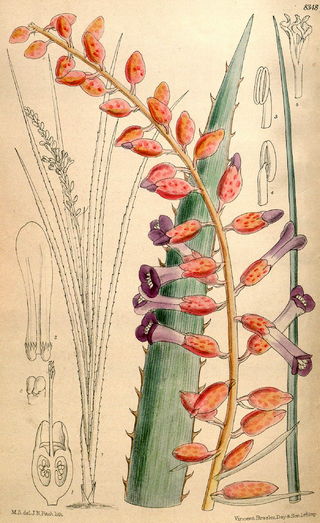
Heliconia is a genus of flowering plants in the monotypic family Heliconiaceae. Most of the 194 known species are native to the tropical Americas, but a few are indigenous to certain islands of the western Pacific and Maluku in Indonesia. Many species of Heliconia are found in the tropical forests of these regions. Most species are listed as either vulnerable or data deficient by the IUCN Red List of threatened species. Several species are widely cultivated as ornamentals, and a few are naturalized in Florida, Gambia, and Thailand.

The Marantaceae are a family, the arrowroot family, or the prayer plant family, of flowering plants consisting of 31 genera and around 530 species, defining it as one of the most species-rich families in its order. Species of this family are found in lowland tropical forests of Africa, Asia, and the Americas. The majority (80%) of the species are found in the American tropics, followed by Asian (11%) and African (9%) tropics. They are commonly called the prayer-plant family and are also known for their unique secondary pollination presentation.
Harri Lorenzi is a Brazilian agronomic engineer, author on trees of the Atlantic Mata and a collaborating agronomist of the garden of Fazenda Cresciumal, Ruy De Souza Queiroz. Between his workmanships, he published four books in the end of the 1990s, which consist of: Brazilian palms, Brazilian Trees, Tropical Plants of Burle Marx and Brazilian Ornamental Plants.

Roberto Burle Marx was a Brazilian landscape architect whose designs of parks and gardens made him world-famous. He is credited with having introduced modernist landscape architecture to Brazil. He was known as a modern nature artist and a public urban space designer. His work had a great influence on tropical garden design in the 20th century. Water gardens were a popular theme in his work. He was deftly able to transfer traditional artistic expressions such as graphic design, tapestry and folk art into his landscape designs. He also designed fabrics, jewellery and stage sets.

Pandanus tectorius is a species of Pandanus (screwpine) that is native to Malesia, Papuasia, eastern Australia, and the Pacific Islands. It grows in the coastal lowlands typically near the edge of the ocean. Common names in English include thatch screwpine, Tahitian screwpine, hala tree and pandanus. The fruit is edible and sometimes known as hala fruit.

Wittmackia is a genus of flowering plants in the family Bromeliaceae.

Orthophytum is a genus in the plant family Bromeliaceae, subfamily Bromelioideae.

Neoglaziovia is a genus in the plant family Bromeliaceae, subfamily Bromelioideae.

The Gustavo Capanema Palace, also known architecturally as the Ministry of Education and Health Building, is a government office building in the Centro district of Rio de Janeiro, Brazil. As the first modernist project in Brazil, it is historically important to the architectural development of Modernism in Brazil and has been placed on Brazil's UNESCO tentative list.

Ctenanthe is a genus of flowering plants of the family Marantaceae described as a genus in 1884. They are evergreen perennials, native to Central and South America. They are grown for their attractive, often variegated foliage. They are frost tender, requiring a minimum temperature of 13 °C (55 °F).

Ctenanthe oppenheimiana, the giant bamburanta or never-never plant, is a species of flowering plant of family Marantaceae and is a native of Brazil. It is an evergreen perennial. This plant can grow to more than 1 m (3.3 ft) tall and broad, with long narrow leaves up to 40 cm (16 in) in length. The leaves are adorned on the secondary veins with dark green bands, which meet and merge in the margins. In between are cream coloured bands. The undersides of the leaves have a red-ish colour. The cultivar 'Tricolor' is a common ornamental variety, which as a houseplant in the UK has gained the Royal Horticultural Society's Award of Garden Merit.. This cultivar is visually very similar to Stromanthe Sanguinea 'Triostar', and the two are often confused. The difference between the two lies in the lack of regular banding on the leaves of the Sromanthe, and the generally more rounded shape of the leaves in Ctenanthe.
Wittmackia burle-marxii is a species of flowering plant in the family Bromeliaceae, endemic to Brazil. It was first described in 1979 as Aechmea burle-marxii.
Hohenbergia burle-marxii is a plant species in the genus Hohenbergia. This species is endemic to Brazil.
Pitcairnia burle-marxii is a plant species of the bromeliad genus Pitcairnia. This species is endemic to Brazil.

Thunbergia erecta, commonly known as the bush clock vine or king's mantle, is a vibrant, evergreen species of shrub in the family Acanthaceae. Native to the forest zone stretching from Guinea-Bissau to western Cameroon, it has found significant cultivation worldwide due to its ornamental appeal and versatility. The plant is particularly known for its erect or scandent growth habit, reaching a notable height of up to five meters or more. This robust shrub displays a fascinating range of pale to dark violet-purple flowers that contribute to its visual appeal and broad popularity. Each flower measures between 5.0 to 7.5 cm in length, hosting a stark white tube at their core. This striking color contrast lends an undeniable charm to the plant, making it a favored choice in various garden settings and landscapes.

Maranta leuconeura, widely known as the prayer plant due to its daily sunlight-dependent movements, is a species of flowering plant in the family Marantaceae native to the Brazilian tropical forests. It is a variable, rhizomatous perennial, growing to 30 cm (12 in) tall and broad, with crowded clumps of evergreen, strikingly-marked oval leaves, each up to 12 cm (5 in) long. The plant spreads itself horizontally, carpeting an entire small area of forest floor, sending roots into the substrate at each leaf node.

Philodendron burle-marxii is a plant in the genus Philodendron native to South America from Colombia to Ecuador and Brazil. Named after the landscape architect Roberto Burle Marx, it is one of over 50 plants that bear his name. This aroid can climb, and has green cordate leaves..The variegated Philodendron Burle marxii is its variety that displays leaves with yellow and white coloring.

Goeppertia cylindrica is a species of plant in the Marantaceae family. It is native to eastern and central Brazil.

Goeppertia burle-marxii is a species of plant in the Marantaceae family native to Brazil. It is named after Roberto Burle Marx. Common names for Goeppertia burle-marxii include "Blue Ice Calathea" and "White Ice Calathea".













